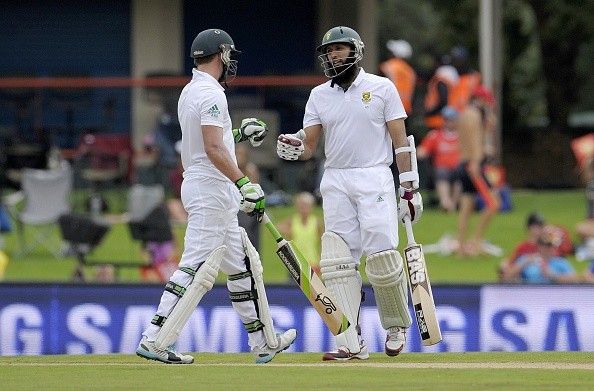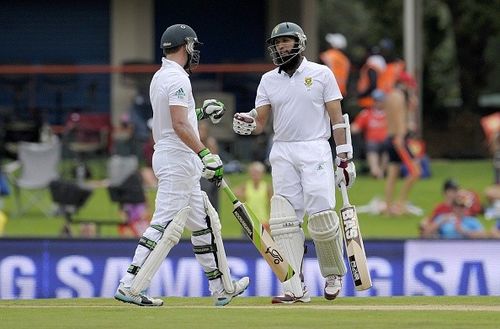
Will South Africa kill Test cricket with their defensive tactics?

India managed to comprehensively beat South Africa in the Test series, but not before an ultra-defensive batting display by the visitors created ripples across the cricketing world.
South Africa's resilient batting causing furore
Hashim Amla, AB de Villiers and Faf du Plessis combined to consume 638 balls, which yielded just 78 runs. For innings with more than 200 balls as qualification, Amla’s is the slowest ever in Test cricket (SR 10.24).
His bland batting was matched by Abraham de Villiers, who holds the record for the fastest 50, 100 and 150 in One-Day Internationals. He showed his versatility by getting off the mark after 33 balls, and not finishing before he had consumed 297 balls and 354 minutes for his 43 runs. The knock was reminiscent of his similar effort against the Aussies in 2012 when he dug in for a 220-ball 33.
Brian Lara took to his Twitter handle to express his displeasure at South Africa’s approach “from a spectator’s point of view”. He pointed out how a young West Indian team successfully chased down 413 against Australia in 2003, and how the slow approach won’t help to promote the game or filling stands.
Michael Holding, the former West Indian bowling great, had expressed his opinion a few months ago on how Test cricket is slowly losing its relevance, especially because the shorter formats are more entertaining to the masses.
Day-Night matches the way forward for Test cricket?
While the Delhi match was on in one side of the globe, the other hemisphere was hosting a unique digression in Test cricket, the first day-night Test match. The television ratings, as well as the crowd response, has been huge, as has been the level of cricket.
More than 47,000 people filled the stands in Adelaide on the first day of the historic Test between Australia and New Zealand. TV viewership also reached a new high, as more than 3 million Australians watched the proceedings from their television. Former cricketers like Courtney Walsh and Ian Chappell have praised the innovative move and have stated that it might revive Test cricket in the long run.
Amla explains South Africa's approach
The stonewalling technique of Amla and de Villiers garnered praise from cricket purists, who acknowledged the difficulty of curbing one’s instincts to save the game. Amla defended his strategy by saying that the team was trying to gain something from the already lost Test series.
He pointed out that no batsman likes blocking every delivery, but the need of the time was to play as long as possible. Heroic as they were, their efforts weren’t enough to prevent India from achieving their biggest victory ever in terms of runs.
Often, presenting a dead bat to every ball makes the batsman fall into a rut. The loop of playing every ball the same way has its demerits, and it is very easy to lose focus. The South African team should be lauded for their efforts, and if it weren’t for a gem of a spell from Ashwin, the game might have been saved.
It requires immense talent and concentration of the highest order, and the Proteas almost managed to pull off the improbable. The application of a strong defence and the ability to squander multiple attempts by the spinners on dustbowls is another facet of South Africa’s famed lineup. It is one of the reasons why they have been the No.1 side and have had an enviable record abroad.
Finding the right balance is key
Yet, if Tests are being observed as an endangered species, their efforts are detrimental in bringing the public back to watching five days of cricket. The monotony of watching inactive passages of play won’t excite fans, as much as they’ll bring a twinkle in the eye of the traditionalists.
The doggedness of scoring at just a run a ball will hardly thrill youngsters, who are swayed by the razzmatazz of T20 matches.
Once in a while, the true and pure form of batting can make the game interesting. But, it should be based on the conditions and state of the match, and should not be exercised as an approach to the game.
With the Test series already lost, the technique of staving off defeat by dead-batting killed the competitiveness, if there was any. It was a method of acknowledging their shortcomings, and an attempt to spend time in the middle.
If that is what the plan was, then it nearly came off for the South Africans. But these valiant attempts won’t mend cracks that are increasingly burdening the game’s original form. The unpredictability and variance of the game are turning out to be its biggest challenges.
It is either up to the fans to embrace the Test cricket of old and move beyond the statistics of runs and strike rates to accept its intrinsic beauty. Or is it up to the game to change with the changing times, and evolve into something that is unique and holds its own even among its more colorful versions?